Circular shape

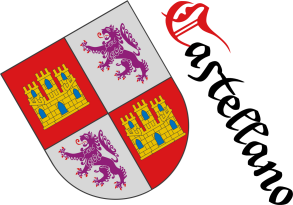
Attitudes of the lion of Ferdinand II
Selection of various lion attitudes: passant, statant, sejant, almost rampant and in one case regardant, in 6 examples of the great seals of King Fernando II of León from 1160 to 1187.
These 6 seals come from the following 3 sources: [Fernando II de León; 1167], [Fernando II de León; 1181] and [Martín Fuertes, J. A.; 2002].
Categories: Personal, Seal, Round, Kingdom of León, Without divisions, One, Lion, Passant, Statant, Sejant, Rampant, Regardant and Motto (identification).
Root: Ferdinand II of Leon.


Ferdinand II of Leon
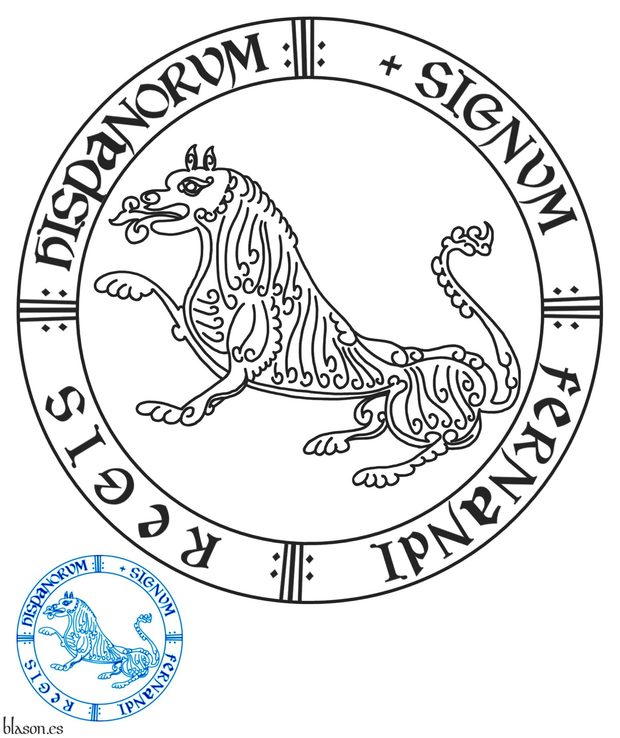
Round seal, a lion sejant. Circular motto: «Signum Fernandi Regis Hispanorum».
Sello rodado, un león sentado. Divisa circular: «Signum Fernandi Regis Hispanorum».
Existing seal interpreted by me as follows: the shape of the seal is circular; the motto is written in sable on its outer ring; inside, a seated lion that begins to be rampant and will eventually become so; y the whole rendered in flat sable ink; y the result is an impression in azure ink.
For the outline of the lion I have followed the round seal of the king in his «Charter of Benavente» [Fernando II de León; 1167], in which I consider the lion to be seated; although it could also be interpreted as rampant, or as intending to be so, as it will ultimately appear in the arms of his son, King Alfonso IX of León.
For the delineation of the motto I have followed the round seal of the king in his «Charter of the Alfoz of Benavente» [Fernando II de León; 1181], in which the lion, unlike the previous one, is clearly in a passant posture.
In [Martín Fuertes, J. A.; 2002] four other round seals of King Fernando II of León can be consulted:
- from the year 1160 (A.C. de León, number 4168) with a lion passant,
- from the year 1165 (A.C. de León, number 1041) with another lion passant,
- from the year 1168 (A.C. de León, number 170) with a lion statant, also described as arrested or at rest, as mentioned in [Avilés, J.; 1725a; page 37] and [Avilés, J.; 1780a; page 42].
- from the year 1187 (A.C. de León, number 1067) with a lion passant and regardant, that is, with its head turned toward the sinister side of the round seal, a posture described, for example, in [Avilés, J.; 1725a; page 55] and [Avilés, J.; 1780a; page 61].
In attitudes of the lion of Ferdinand II the attitudes discussed in this article are illustrated.
Blazon keywords: Without divisions, One, Lion, Sejant and Motto (identification).
Style keywords: Round, Plain tincture and Sealed.
Classification: Interpreted, Personal, Seal and Kingdom of León.
Bearer: Ferdinand II of Leon.


Ferdinand II, Signum Regis Hispanorum
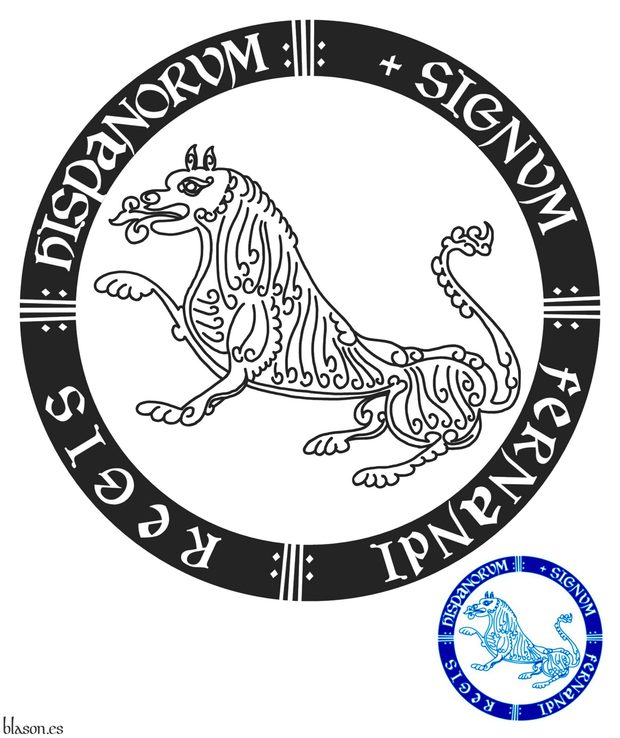
Born in 1137, King of León from 1157 to 1188, died in Benavente on January 22, 1188.
Round seal, a lion sejant. Circular motto: «Signum Fernandi Regis Hispanorum».
Sello rodado, un león sentado. Divisa circular: «Signum Fernandi Regis Hispanorum».
Existing seal interpreted by me as follows: the shape of the seal is circular; the legend is written within an outer black border; inside, a seated lion, not so much rampant and even less passant; the whole rendered in flat sable ink; and the result glazed with azure ink.
I use the term "legend" for its identifying purpose regarding King Fernando II of León; note that among the terms motto, legend, device, and war cry, all referring to texts in the blazon, different nuances and meanings can be found.
Blazon keywords: Without divisions, One, Lion, Sejant and Motto (identification).
Style keywords: Round, Plain tincture and Sealed.
Classification: Interpreted, Personal, Seal and Kingdom of León.
Bearer: Ferdinand II of Leon.


Martos García, Juan Carlos, ex libris
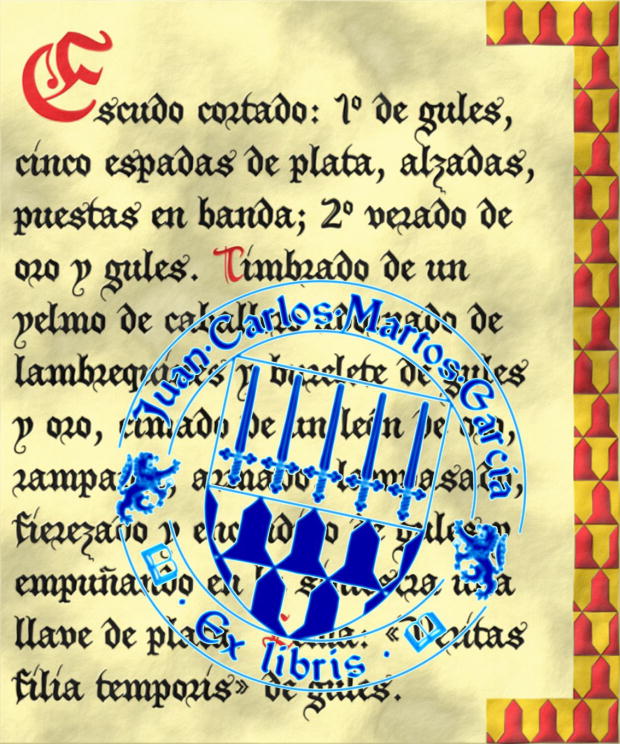
Ex libris created with the coat of arms. The ex libris is supported by two lions rampant and surrounded, in its upper part, above the lions, by the full name of the holder of the gentilic coat of arms and, in its lower part, below the lions, by the device «ex libris» accompanied by two open books.
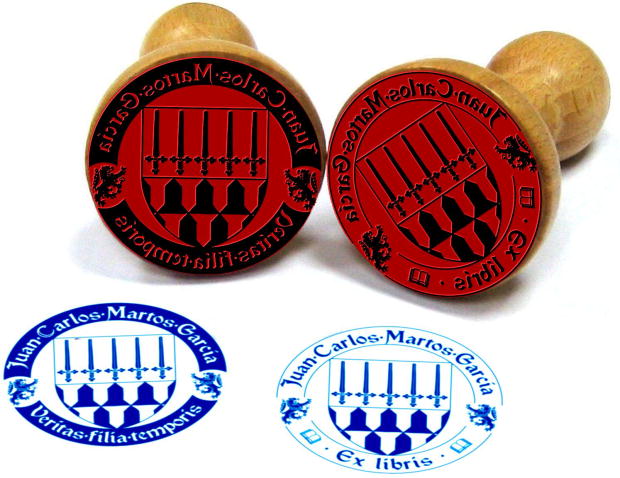
In the first side image of this article the result of stamping this ex libris with Azure ink on a parchment bearing the blazon of the coat of arms. The ivory-colored parchment is decorated with a frame formed by a vairy Or and Gules that is also used to decorate the heraldic catalogue and in the second image both the seal and this ex libris of rubber with wooden handles, both stamped on white paper with Azure ink.
The Latin term «ex libris» ~ «exlibris», in Spanish, means «de entre los libros de». Therefore, when a book is marked with the ex libris of a person or an entity, it indicates that it belongs to the set of books in the library of that person or entity, whether private or public.
The Spanish term «exlibris» is defined by [Real Academia Española; 2014] as «A label or engraved stamp that is stamped on the inside of the book cover, in which the name of the owner or that of the library to which the book belongs is stated», in the case illustrated in this article, it corresponds to a «sello» that is stamped with ink.
Blazon keywords: Azure, Motto, Motto (identification), Five, Sword, Vairy, Point upwards, In fess, Supporter (animal), Supporter, Lion and Rampant.
Style keywords: Round, Sealed and Plain tincture.
Classification: Created, Personal and Seal.
Bearer: Martos García, Juan Carlos.


Martos García, Juan Carlos, seal
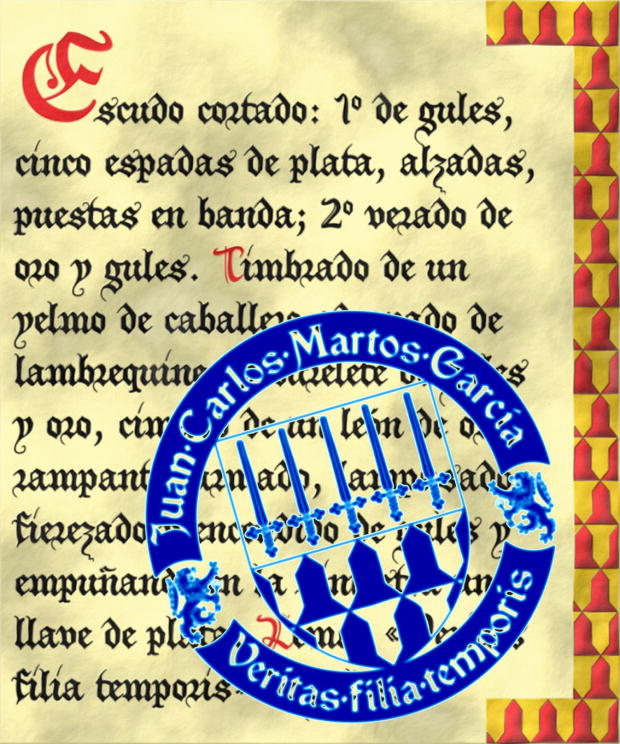
Seal created with the gentilic coat of arms in a pointed shape. The seal is supported by two lions rampant and surrounded, in its upper part, above the lions, by the full name of the holder of the gentilic coat of arms and, in its lower part, below the lions, by the holder's motto «Veritas filia temporis». In the side image, heraldically to sinister, the result of stamping this seal with Azure ink on a parchment. The parchment is decorated with a frame formed by a vairy Or and Gules and bearing the blazon of the coat of arms.
Blazon keywords: Azure, Motto, Motto (identification), Five, Sword, Vairy, Point upwards, In fess, Supporter (animal), Supporter, Lion and Rampant.
Style keywords: Round, Sealed and Plain tincture.
Classification: Created, Personal and Seal.
Bearer: Martos García, Juan Carlos.
-
Language
-
Categories of heraldry
-
Divisions of the field
- Without divisions
- Party per pale
- Party per fess
- Party per bend
- Party per bend sinister
- Tierce
- Tierce sinister
- Tierced per pale
- Tierced per fess
- Tierced per bend
- Tierced pallwise inverted
- Quarterly
- Quarterly per saltire
- Gyronny
- Party per fess, the chief per pale
- Party per pale, the sinister per fess
- Party per fess, the base per pale
- Party per pale, the dexter per fess
- Chapé
- Chaussé
- Embrassé
- Contre-embrassé
- Party per chevron
- Enté
- Enté en point
- Flanched
-
Metals
-
Colours
-
Furs
-
Other tinctures
-
Ordinaries and sub-ordinaries
-
Diminutives of the ordinaries
-
Geometric charges
-
Composite ordinaries
-
Inanimate charges from Nature
Atom, Crescent, Diamond, Emerald, Estoile, Increscent, Lightning flash, Moon, Mount, Mullet, Mullet of four points, Orbital, Plough of Ursa Major, Rainbow, Ray of the sun, River, Sea, Snowflake, Sun, Sun in splendour, Sun of May, Trimount, Water and Wave.
-
Vegetal charges from Nature
Acorn, Apple, Apple tree, Ash, Bluebonnet, Camellia, Chrysanthemum, Cinquefoil, Cornflower, Dogwood flower, Double rose, Elm, Fleur de lis, Flower, Gourd, Holm oak, Hop cone, Kapok tree, Laurel, Lily, Linden, Lotus flower, Madonna lily, Mexican cedar tree, Oak, Olive tree, Palm tree, Plantain plant, Pomegranate, Poplar leaf, Rose, Shamrock, Sunflower, Thistle, Tree, Tulip, Vine and Wheat.
-
Animal charges from Nature
Badger, Bald eagle, Barbel, Barn owl, Bear, Beaver, Beetle, Bighorn sheep, Blackbird, Boar, Brach hound, Bull, Doe, Dog, Dolphin, Dove, Eagle, Elephant, Falcon, Female figure, Fish, Flame, Fly, Fox, Frog, Goat, Goldfinch, Goose, Heron, Horse, Hummingbird, Jaguar, Lark, Leopard, Lion, Lion passant, Lion rampant guardant, Lioness, Lynx, Male figure, Martlet, Merino ram, Owl, Panther, Parrot, Peacock, Pelican, Pelican in her piety, Puffin, Quetzal, Raven, Roe deer, Rooster, Savage, Seagull, Serpent, She-wolf, Stag, Starling, Talbot, Tyger, Vulture, Warren hound and Wolf.
-
Parts of natural charges
Arm, Beak, Branch, Caboshed, Chest, Claw, Covert, Dorsal fin, Eagle claw, Ermine spot, Escallop, Feather, Foot (palmiped), Foreleg, Forepaw, Hand, Head, Heart, Hoof, Leaf, Neck, Ostrich feather, Palm frond, Paw, Roe deers' attires, Shoulder, Sprig, Stags' attires, Stem, Swallow-tail, Tail, Tail addorsed, Tail fin, Talon, Tooth, Trunk, Trunk (elephant), Two hands clasped, Two wings in vol, Udder, Wheat spike, Wing and Wrist.
-
Artificial charges
Ace of spades, Anchor, Anvil, Arch, Arm vambraced, Armillary sphere, Arrow, Axe, Bell, Bell tower, Beret, Bonfire, Book, Bookmark, Bow, Branding iron, Bridge, Broken, Buckle, Cannon, Cannon dismounted, Cannon port, Canopy roof, Carbuncle, Castle, Celtic Trinity knot, Chain, Chess rooks, Church, Clarion, Clay pot, Closed book, Club, Column, Comb, Compass rose, Conductor's baton, Cord, Covered cup, Crozier, Crucible, Cuffed, Cup, Cyclamor, Dagger, Double vajra, Drum, Ecclesiastical cap, Fanon, Federschwert, Fleam, Four crescents joined millsailwise, Galician granary, Garb, Gauntlet, Geometric solid, Grenade, Halberd, Hammer, Harp, Host, Hourglass, Key, Key ward, Knight, Knot, Lantern, Letter, Line, Loincloth, Menorah, Millrind, Millstone, Millwheel, Monstrance, Mortar, Mullet of six points pierced, Nail, Non-classic artifact, Norman ship, Number, Oar, Oil lamp, Open book, Page, Pair of scales, Parchment, Pestle, Piano, Pilgrim's staff, Plough share, Polish winged hussar, Port, Portcullis, Potent, Quill, Ribbon, Rosette of acanthus leaves, Sabre, Sackbut, Sail, Scroll, Scythe, Sheaf of tobacco, Ship, Skirt, Spear, Spear's head, Stairway, Star of David, Step, Sword, Symbol, Tetrahedron, Torch, Tower, Trident, Trumpet, Turret, Two-handed sword, Wagon-wheel, Water-bouget, Wheel, Winnowing fan and With a turret.
-
Immaterial charges
Angel, Archangel, Basilisk, Dragon, Dragon's head, Garuda, Golden fleece, Griffin, Heart enflamed, Justice, Mermaid, Our Lady of Mercy, Ouroboros, Paschal lamb, Pegasus, Phoenix, Sacred Heart of Jesus, Saint George, Sea-griffin, Trinity, Triton, Unicorn, Winged hand and Wyvern.
-
External elements
-
Heraldic creations
-
References
-
Formats
-
Keywords on this page
Point upwards, Azure, Five, Round, Regardant, Created, Motto (identification), In fess, Sword, Sealed, Ferdinand II of Leon, Personal, Interpreted, Motto, Lion, Martos García, Juan Carlos, Statant, Passant, Without divisions, Rampant, Kingdom of León, Seal, Sejant, Supporter (animal), Supporter, Plain tincture, One and Vairy.

